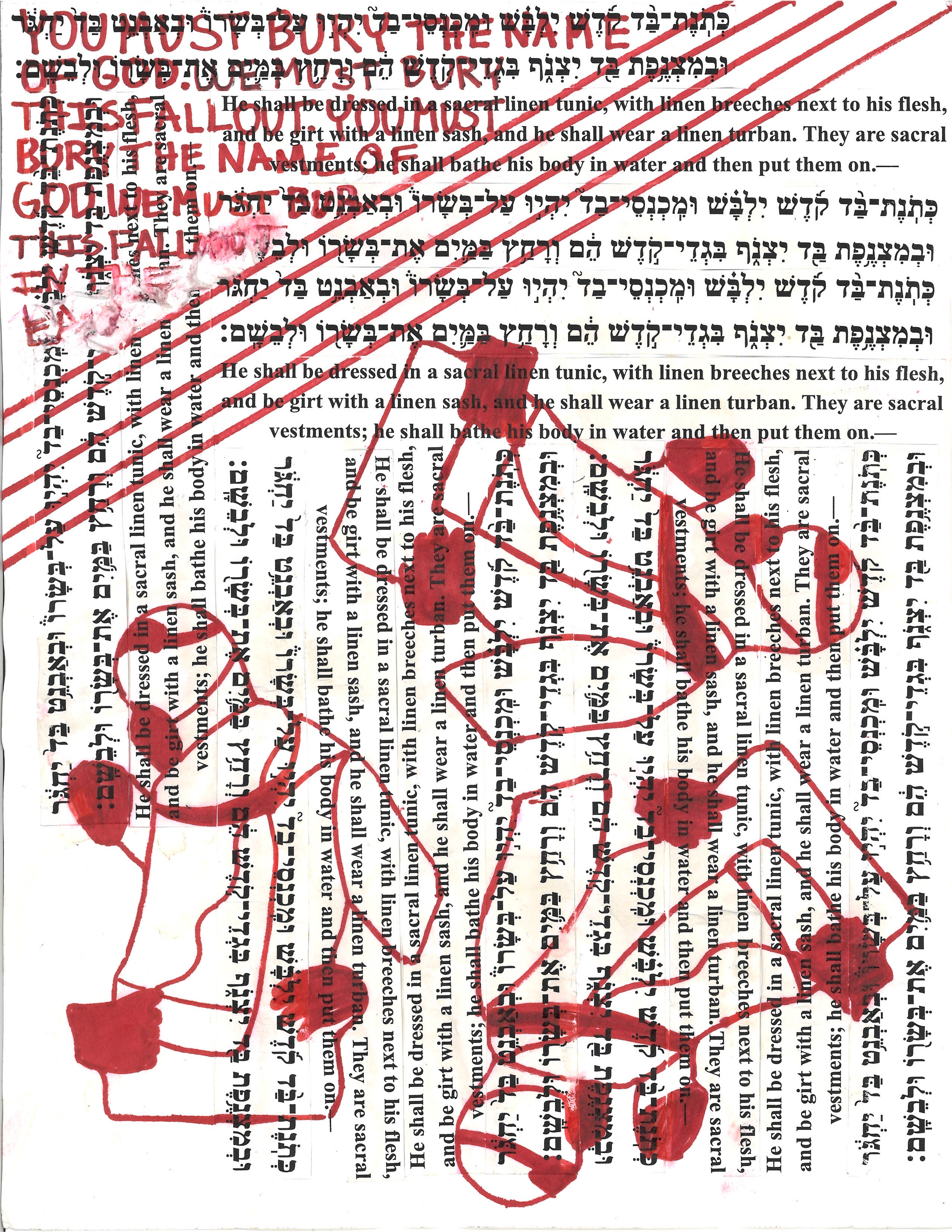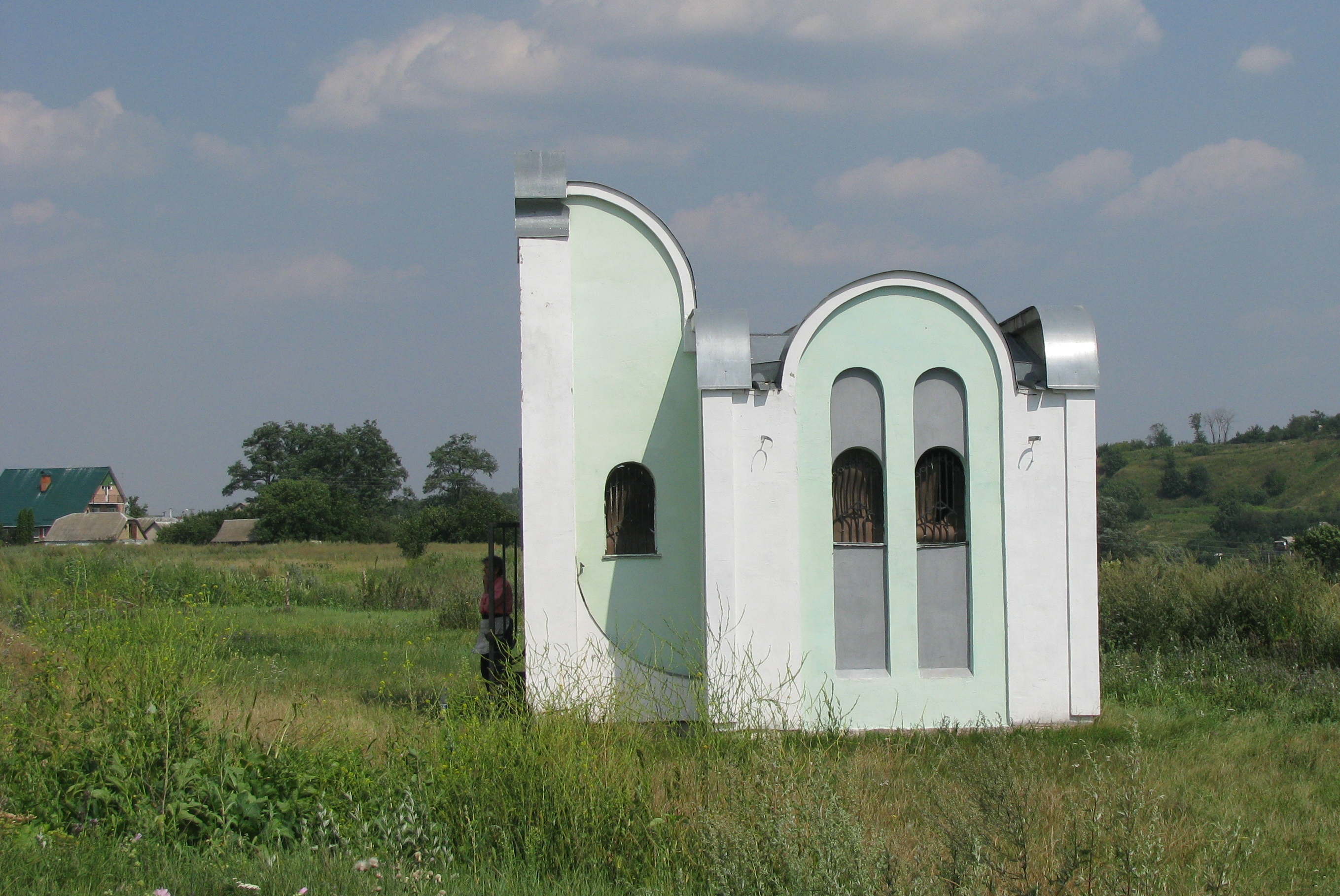Introduction
This project explores the intersection of belief practices, faith, and the nuclear culture that emerged in the aftermath of the Chornobyl incident. As I read over the multiple professions of faith that came from Voices from Chernobyl, a book composed entirely of quotations of survivor’s accounts, a surprising similarity emerged between how people approached the holy in their lives and how they approached the nuclear source in Chornobyl, both having tremendous effects on people who worship them, either through traditional religious observation of a deity or through religious-like devotion to a place/ideal such as the Chornobyl incident. I made a scrapbook to combine these concepts in a more material way, placing the ideas of the Holy with that of the nuclear next to each other. Both the Holy and the Nuclear occupy a similar space in the mindscape of Chornobyl, large-scale concepts that are uncontrollable, unseeable, and eternal or seemingly eternal. In order to analyze these connections, I created four collaged pages: Reflection on Wormwood, Reflection on Iconography, Reflection on Shared Space, and Reflection on Burial.
The inspiration for the first page, Reflection on Wormwood came from the fact that the word, Chornobyl, “(pronounced in Ukrainian chor-no-bll) comes from two common, and ancient, roots meaning, literally, “black (or dark) plant,” and also “is the name of a local variety of the perennial weed, or semi bush” (Palij & Fletcher, 23) that is labeled as Wormwood in English. Those with biblical education might notice a coincidence between the town’s names meaning to that of the biblical passage of Revelation 8.10-11, where “the name of the star is Wormwood” (NIV). By placing the exact words of this excerpt over images of this scene from Revelation in English, Ukrainian, Russian, and Belarusian, I wanted to combine the more historical view of Wormwood, particularly the medieval depictions of it as an actual star, with that of invisible radiation that stemmed from the Chornobyl incident. The empty space of the words represents the power of radiation, permeating and cutting through without even being visible.
The second page, Reflection on Iconography, seeks to recreate the Icon of Chernobyl, located in the Prophet Elijah Church in Chornobyl. The old church has been operational since the late 16th century, closed briefly from 1986 to 2001, and resumed their services after that point. The dedication given to the creation of icons in Russian Orthodoxy mimics that of the creation of schematics for large-scale industrial factories such as the Chornobyl Nuclear Plant. Both were standards of the community, as the Chornobyl plant was the center of economic activity in the area while the Russian Orthodox faith was the cornerstone of people’s spirituality. Faith in the holy and faith in nuclear power were both torched by the incident, where every aspect had to be questioned and examined by those who experienced them. The burnt pages and sketches of holy figures seek to recreate these emotions.
The third page, Reflection on Shared Space, aims to combine places of faith with the Chornobyl Nuclear Plant. A large Hasidic community lived in Chornobyl, and the synagogue that they used is still standing. The Prophet Elijah Church, as mentioned before, also continues to run services in the area, but it is still impacted by the radiation that the area experienced, although to a lesser extent. I overlaid a cutout of the Chornobyl Nuclear Plant from today that I traced myself and drew images of these religious spaces onto the page. As the Chornobyl Nuclear Plant inspired similar, almost religious attention from the plant workers, through the daily rituals and maintenance of the plant, the space required a similar amount of dedication, fervor, and attention to keep it in functional order. All of these spaces also became abandoned after the incident and thus suffered a similar vacancy in their boundaries.
The fourth page, Reflection on Burial, draws inspiration directly from Leviticus 16.4. Achrei Mot, as called in the Tanakh, is the 16th part of Levicticus and literally means “after the death of” and is written after the death of Aaron’s two sons. It explicitly addresses rules and how to approach the “holy,” saying that only the high priest, once a year on Yom Kippur, dressed in the proper wrapping and clothing, can do so. This is extremely similar to the way that the liquidators who cleaned up Chornobyl had to dress, furthering the comparison between the nuclear and divine. Getting close to it is dangerous, even if one can not see or act upon it. In a similar way to how the name of God must traditionally be buried in a specific way based on Judaism, called Genizah, nuclear waste from Chornobyl was buried after the incident.
The construction of this scrapbook is based around the similarities of the nuclear culture and faith culture (particularly the aspects of the rituals of approaching the Holy or the Divine), especially what happens when these procedures or rituals are broken. My focus was mainly on how nuclear power is treated as “godlike” based on how nuclear culture developed and how this approach mirrors the power of God to people of faith. Failure to adhere to rituals of how to approach both Nuclear and the Holy appear in the aftermath of Chornobyl, the Tanakh, and the Bible, which manifests in the placement of images and contrasts in the scrapbook.
Page 1: Reflection on Wormwood

Physical Description: On top of a composition of historical paintings of the biblical wormwood, a white piece of paper lies, composing about 75% of the page, with Revelation 8.10-11 in English, Ukrainian, Russian, and Belarusian cut out. The edges of the white paper are slightly dirtied, and the pictures peek through the cutouts.
Text on page: “And the third angel sounded, and there fell a great star from heaven, burning as it were a lamp, and it fell upon the third part of the rivers, and upon the fountains of waters; And the name of the star is called Wormwood: and the third part of the waters became wormwood; and many men died of the waters, because they were made bitter. І засурмив третій Ангол, і велика зоря спала з неба, палаючи, як смолоскип. І спала вона на третину річок та на водні джерела. А ймення зорі тій Полин. І стала третина води, як полин, і багато з людей повмирали з води, бо згіркла вона… Третий Ангел протрубил в свою трубу, и с неба упала огромная звезда, пылая словно светильник. И упала она на треть рек и источников. Имя звезды было «Полынь», и треть всех вод стала горькой. Многие умерли от этой воды, так как стала она горькой. І трэці анёл затрубіў, і ўпала з неба вялікая зорка, якая гарыць, як паходня, і ўпала на трэцюю частку рэкаў і на крыніцы водаў, і імя зоркі называецца Палын; і трэцяя частка сталася палынам, і шмат людзей памерла ад тых водаў, бо яны сталі горкімі.”
Materials: Printer paper, white cardstock, printed black and white images, glue, and black sharpie.
Page 2: Reflection on Iconography

Physical Description: On top of burnt schematics of the Chornobyl Nuclear Plant, three diamond-shaped shapes and one rectangular shape lie. In the top diamond, there is an abstract drawing of a cross in black with a gas mask atop the cross, the eyes colored red. Text explaining the Trinity lies behind this image. In the left diamond, there is a recreation of the Virgin Mary with measurement lines arranged about her. Inside of the outline, there lie red dots outlining part of the figure. In the right diamond, the shape is divided into four triangles, consisting of alternating portrayals of abstract crosses and fuel rods. The rectangle is located at the bottom of the page and contains an abstract drawing of a tree overlaid with a sketch of the same tree.
Text on page: “Father glorifies the Son. The Son glorifies the Holy Spirit. The Holy Spirit glorifies the Father. The Father is not the Son. The Son is not the Holy Spirit. The Holy Spirit is not the Son. The Son is not the Father. The Father is GOD. The Holy Spirit is God. The Son is GOD.
Materials: Printer paper, white cardstock, black sharpie, red sharpie, glue, lighter, and red pen.
Page 3: Reflection on Shared Space

Physical Description: A recreation of the building map for the Chornobyl Nuclear Plant lies atop a white page, with the cutouts both making the layout and revealing black paper underneath. On the upper left side, a recreation of the Church of the Prophet Elijah in Chornobyl is drawn in red. On the bottom right side, a recreation of the Chornobyl Synagogue is drawn in red. Around the page, there are assorted quotes from Voices from Chernobyl, each of them written in red.
Text on page: “There used to be Communism instead of God, but now there’s just God. So we pray.” (47) “Only man stands up, and raises his hands and face to the sky. To prayer. To God.” (66) “Faith in the land, in their ancient peasant experience– even the death of their son can’t overturn the order of things.” (128) “But if it’s colorless, then it’s like God. God is everywhere but you can’t see Him.” (51) “Some gods would have done it, but He didn’t let me die. I’m alive.” (39) “One old woman, she promises that we’re immortal. We pray. Oh Lord, give us the strength to survive the weariness of our lives.” (50) Quote Page Numbers: (Alexievich, 47, 66, 128, 51, 39, & 50)
Materials: Printer paper, white cardstock, black sharpie, red sharpie, glue, red pen, pencil, and black construction paper.
Page 4: Reflection on Burial

Physical Description: On a white page of paper, Leviticus 16.4 is printed in both Hebrew and English, arranged in various geometric ways, although none overlap. A series of five diagonal lines separate the top 25% of the page from the bottom. In the bottom half, multiple outlined drawings of liquidators are drawn in red on the page. In the top left corner, a section of text is written in red.
Text on page: כְּתֹֽנֶת־בַּ֨ד קֹ֜דֶשׁ יִלְבָּ֗שׁ וּמִֽכְנְסֵי־בַד֮ יִהְי֣וּ עַל־בְּשָׂרוֹ֒ וּבְאַבְנֵ֥ט בַּד֙ יַחְגֹּ֔ר וּבְמִצְנֶ֥פֶת בַּ֖ד יִצְנֹ֑ף בִּגְדֵי־קֹ֣דֶשׁ הֵ֔ם” וְרָחַ֥ץ בַּמַּ֛יִם אֶת־בְּשָׂר֖וֹ וּלְבֵשָֽׁם׃” “He shall be dressed in a sacral linen tunic, with linen breeches next to his flesh, and be girt with a linen sash, and he shall wear a linen turban. They are sacral vestments; he shall bathe his body in water and then put them on.—” “YOU MUST BURY THE NAME OF GOD. WE MUST BURY THIS FALLOUT”
Materials: Printer paper, black and white printouts, red sharpie, glue, red pen, and soda.
Bibliography
-
Alexievich, Svetlana, and Keith Gessen. Voices from Chernobyl. Dalkey Archive Press, 2019.
-
“Bible Gateway Passage: Revelation 8 - New International Version.” Bible Gateway, www.biblegateway.com/passage/?search=Revelation+8&version=NIV. Accessed 6 Nov. 2023.
-
Conca, James. “Chernobyl through the Mist of Decades.” ANS, 7 Apr. 2016, www.ans.org/news/article-1816/chernobyl-recalled-at-three-decades/.
-
“Leviticus 16:2.” Sefaria, www.sefaria.org/Leviticus.16.2?aliyot=0. Accessed 6 Nov. 2023.
-
Malko, Mikhail. The Chernobyl Reactor: Design Features and Reasons for Accident - Kyoto U, www.rri.kyoto-u.ac.jp/NSRG/reports/kr79/kr79pdf/Malko1.pdf. Accessed 7 Nov. 2023.
-
Palij, Michael, and William C Fletcher. “CHORNOBYL’: AN ETYMOLOGY.” The Ukrainian Quarterly, vol. 42, no. 1–2, 1986, pp. 22–24.
Madeline Muller ‘25 is a Junior Russian and Comparative Literature Major at Bryn Mawr College. She enjoys scrapbooking (obviously) and enjoyed exploring the faith aspect for the Reactor Room Project though a creative process.
RUSSB220 Chornobyl, Bryn Mawr College, Fall 2023
Licensed under CC BY-NC 4.0.
